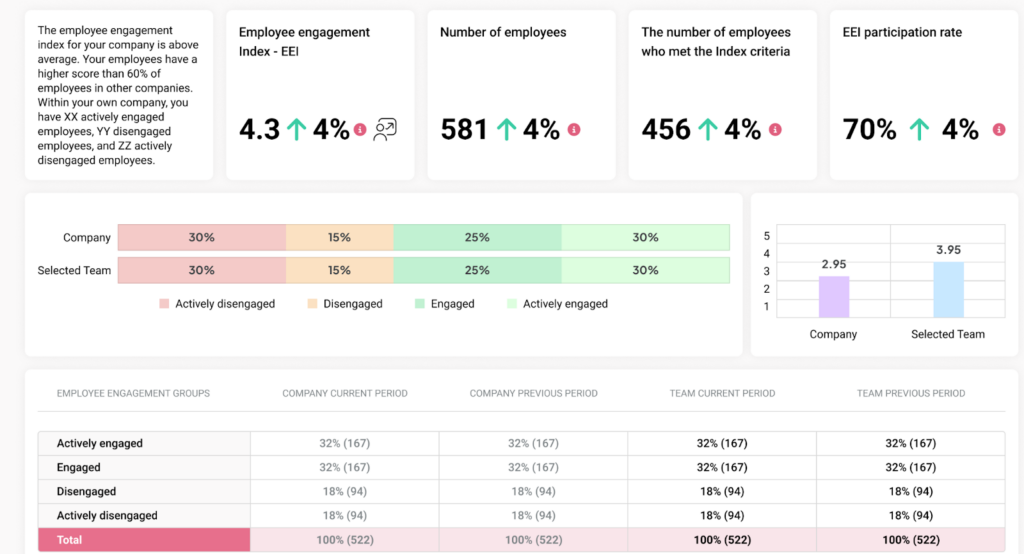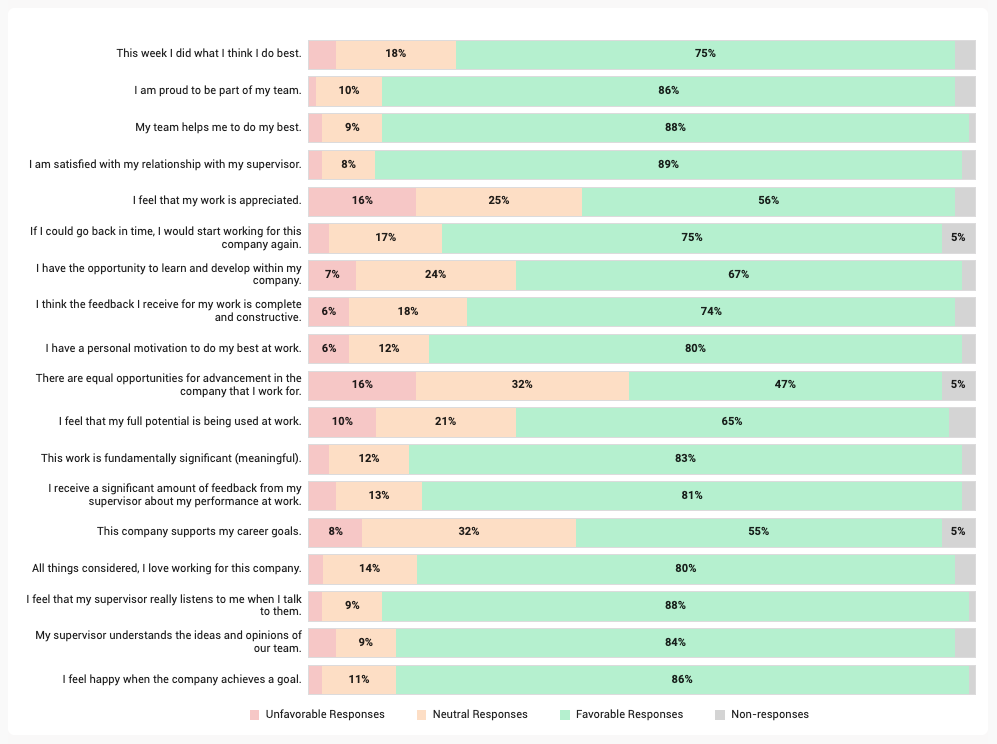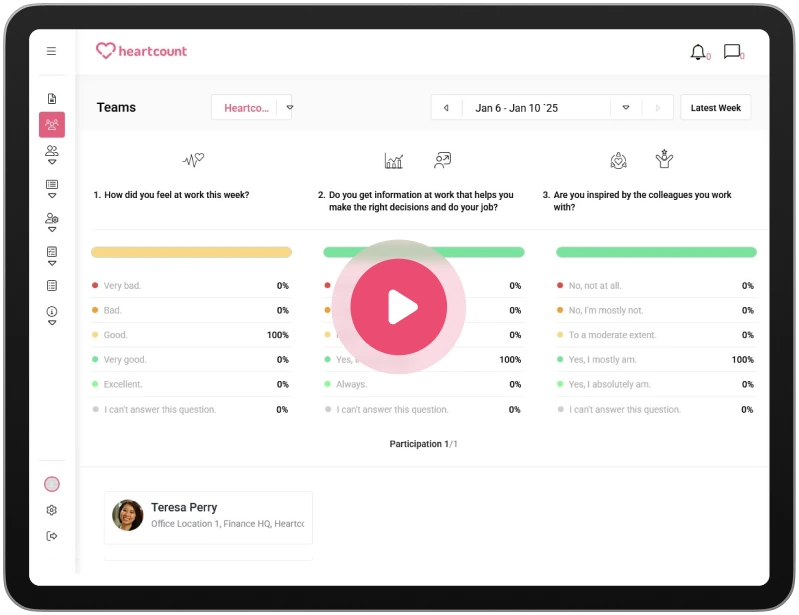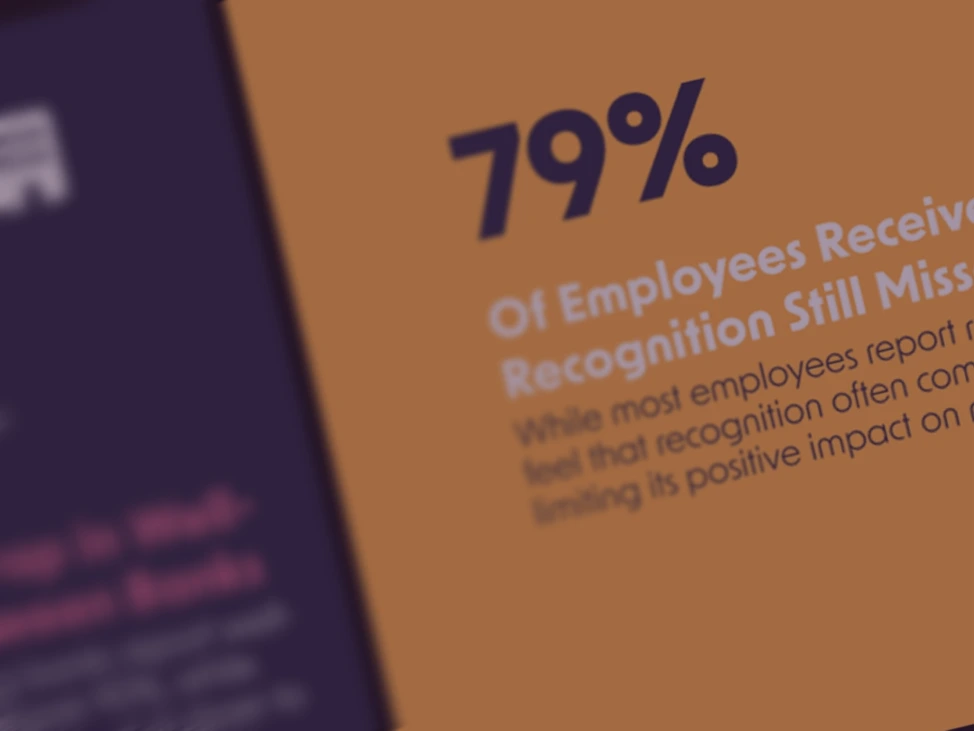Employee engagement index (EEI): What it is and how to measure it

How often do you ask employees in your organization if they are satisfied with their work or feel recognized for it?
Asking questions like “Do you feel valued at your workplace by peers and managers?” allows you to gain insight into employee sentiment, identify and address issues early on, foster open communication between employees, managers, and leaders, align organizational and employee goals, and, ultimately, boost productivity.
However, without powerful employee engagement metrics, it will be challenging to understand engagement levels in your organization clearly. One such metric is the employee engagement index, and it is the secret sauce to building a more productive and engaging workforce.
How often do you ask employees in your organization if they are satisfied with their work or feel recognized for it?
Asking questions like “Do you feel valued at your workplace by peers and managers?” allows you to gain insight into employee sentiment, identify and address issues early on, foster open communication between employees, managers, and leaders, align organizational and employee goals, and, ultimately, boost productivity.
However, without powerful employee engagement metrics, it will be challenging to understand engagement levels in your organization clearly. One such metric is the employee engagement index, and it is the secret sauce to building a more productive and engaging workforce.
What is an employee engagement index?
The employee engagement index (EEI) is a metric organizations use to evaluate employee engagement within the company. It helps organizations assess how much extra effort employees are willing to put into their roles, which shows their overall engagement and productivity levels.
Key elements of employee engagement index
EEI consists of several key elements. These are:
- Job satisfaction
Job satisfaction is the precursor for employees feeling motivated and engaged. It reflects how well the job and its environment meet the employee’s needs and expectations. It is influenced by different factors such as salary, benefits, culture, growth and development opportunities, etc.
- Commitment
Do your employees feel committed to helping the organization succeed, or are they just “going through the motions?”
Commitment is another crucial element of the EEI that shows whether employees are ready to go with you “through thick and thin” or how willing they are to help the company succeed.
- Enthusiasm
Most people feel initial enthusiasm when starting a new job, but eventually, this enthusiasm fades, and they no longer work with the energy and passion they used to.
Enthusiasm will fluctuate constantly, but if you recognize when and why it drops and address the issue, you will see much more energy from your workforce.
- Going beyond the minimum
Are your employees willing to go “above and beyond” of their formal job duties? Do they put initiative and extra effort into their work, or do they stop at the minimum required of them?
- Organizational alignment
An organization is a team, and if the team’s vision, values, and goals are not aligned, that team can’t succeed.
One of the “copy/paste” answers job recruiters hear from new candidates when asking them, “Why do you want to join our team?” is usually “Because your values and goals align with mine.” Make sure this is really the case.
Differences between employee engagement index (EEI) and other metrics
The employee engagement index is not the only KPI used to evaluate employee engagement.
The EEI is distinct from other metrics used to gauge engagement, such as the employee net promoter score (eNPS) and the employee engagement score (EES)
First, the EEI and eNPS differ considerably, particularly in their purpose, methodologies, scope, and more.
| Employee engagement index (EEI) | Employee net promoter score (eNPS) | |
| Purpose | To measure the overall employee engagement level within an organization | To evaluate employee loyalty based on their likelihood to recommend the company as a good place to work |
| Scope | EEI has a broad scope and includes different facets, such as job satisfaction, organizational commitment, motivation, and recognition. | eNPS focuses on one question: “How likely would you recommend our company to others as a workplace?” |
| Format | Typically, EEI consists of several questions that address different employee engagement elements | It consists of a single question rated on a 0 to 10 scale |
| Measurement methodology | Draws from different employee surveys | Based on a single question |
| Insights gained | Gives detailed insight into different areas of employee engagement | Offers a quick glance into employee loyalty and sentiment about the company |
| Output | 0 to 100 percentage score | A score between -100 and 100 |
| Use cases | Identifying specific employee engagement areas of improvement | Assessing overall employee satisfaction |
For example, here’s how the EEI and eNPS results are represented in the HeartCount semiannual report:
First, the report shows how many of your employees feel actively engaged, engaged, disengaged, or actively disengaged in the company or a selected team for the current previous period based on several questions.

On the other hand, you can see how many of your employees would recommend your company as a place to work from the eNPS part of the report and their overall loyalty:

The HeartCount semiannual report offers both EEI and eNPS metrics, providing clear and valuable insight into employee engagement.
The employee engagement score (EES) is another similar yet distinct metric from the employee engagement index (EEI).
This metric is used primarily to gauge how committed and emotionally invested your employees feel about the organization. It is calculated based on employee engagement survey responses related to job satisfaction, recognition and rewards, and commitment to the organization.
| Employee engagement index (EEI) | Employee engagement score (EES) | |
| Scope | Covers multiple engagement dimensions | A single score |
| Calculation | Combines different engagement indicators | Derives from specific employee engagement survey questions |
| Application | Provides deep insight | Offers a quick glance |
The drivers of employee engagement
Employee engagement is not the result of just one thing. Instead, several factors, from leadership and management to work culture, influence and drive employee engagement, including how motivated employees are and their loyalty and sentiment.
Here’s how each factor “drives” employee engagement”:
Leadership and management
Employees need to trust leaders and managers to perform their tasks well. Influential leaders provide clear directions, support their team, and make employees feel valued and understood.
Work environment and culture
Employees are naturally more invested in their work in an inclusive, collaborative environment where everyone’s goals and values align.
At the same time, if the work culture promotes transparency, respect, and fairness, employees are much more willing to put “a little extra ” into their work.
Career development and growth opportunities
Regardless of how good the job is, if the employee is “stuck” on it for years, they will eventually become disengaged. You must provide employees with enough opportunities for career growth and development.
Consider each employee’s goals of career advancement and skill development. If this path is unclear, don’t expect them to be motivated and committed for long.
Recognition and rewards
Are your employees doing a good job? If so, great, but how often do you thank them for their efforts?
An employee who does not get recognition in the workplace will not feel valued. Is it really hard to say “thank you” and “good job”?
Give your employees a thumbs-up and see them perform even better as a result.
Work-life balance
Your employees do not live 24/7 for the company. They also have personal lives, families, friends, hobbies… in other words, a whole life outside their work. If you want satisfied employees who do not experience burnout often, you must promote work-life balance.
So, next time you want to email them over the weekend or call them at home, consider that they may be spending valuable time with their family.
Why is the employee engagement index important?
The employee engagement index is vital for organizations to measure, understand, and improve employee engagement. It provides clear and quantifiable data and insights into employee engagement, identifies areas for improvement, reduces turnover, enhances productivity, and boosts overall performance.
Here’s how employee engagement levels are intertwined with productivity, retention, morale, customer satisfaction, and financial outcomes.
- Productivity
When employees are adequately motivated and engaged, they will put extra effort into their work, which means they are more productive at their work.
- Retention and lower turnover
Highly engaged employees are much more loyal and less willing to leave the company. In other words, employee engagement heavily contributes to employee retention.
- Employee morale
If there’s one thing that you want your staff to get “infected” with, it’s high morale. High morale means everyone walks into the work environment with a smile and walks out with one. In this kind of positive environment, engagement and productivity thrive.
- Customer satisfaction
If you, as the team leader and manager, do not treat your employees with respect or show them they are valued, you can’t expect them to put that extra effort into their work.
Remember that your employees represent your company with your customers much more than social media or ads ever could. If they are willing to put extra effort into customer service, the customers will recognize that and reward you with their loyalty and repeat business.
- Financial outcomes
Finally, when you combine all of these—productivity, retention, morale, and customer satisfaction—your organization will see better financial outcomes.
How to calculate the employee engagement index?
Methods for gathering employee engagement data
To calculate the EEI, we first need to collect data about employee engagement. There are several methods to do that:
- Surveys
Surveys can help you gather data on employee engagement, satisfaction, experience, workplace culture, and more. Each survey can individually focus on one aspect of employee engagement or be more broad and include all of them. They can be traditional employee surveys or pulse check surveys.
- Interviews
Interviews are one-on-one meetings between the HR or manager and the employee. They usually allow for a more open dialogue than surveys, so they’re a great way to gain valuable insight into the employee’s sentiment on, for instance, why the employee has left (exit interview) or what the employer should do for the employee to stay (stay interview).
- 360-degree feedback
The 360-degree feedback gathers feedback on employee performance and engagement from various sources, including supervisors, peers, and subordinates. This allows HR managers to get a holistic view and identify strengths and areas for improvement from multiple sources and viewpoints.
- Employee lifecycle data
Naturally, employee engagement levels will change over the different stages of their career lifecycle. Therefore, it’s vital for the organization to continuously gather this data to understand engagement at different employment stages.
- Focus groups
Focus groups are facilitated discussions where employees share their opinions and feelings about a specific topic to help managers or HR gain deeper insight into their engagement level.
After gathering the data using any of these methods or a combination of a few, you can analyze the results.
This allows you to identify strengths, weaknesses, and areas for improvement in employee engagement.
Analyzing employee engagement data in a structured way
This calls for a strategic and systematic approach.
- Consolidate your data
Especially if you are using multiple methods for gathering data (like pulse check surveys, 360-degree feedback, and stay/exit interviews), all this data will end up in different places.
You need to consolidate all these sources into one centralized database. That way, you won’t have to chase your data everywhere, you get a comprehensive overview, and it becomes much simpler to cross-analyze it when necessary.
- Segment the data
While it’s sometimes helpful to have data covering the entire organization, you’re usually looking to identify patterns and trends within a specific group. This can be a department (sales, operations, IT…, etc.), roles (sales managers, accountants, quality control…, etc.), demographics, or some other segmentation factor that works in your case.
- Quantitative and qualitative analysis
Once you’ve consolidated and segmented the data, the actual analysis part can begin.
This consists of a quantitative and qualitative analysis.
For the quantitative analysis, begin by picking a descriptive statistic, like a standard deviation or a median. This will help you better understand any overall trends in your scores.
You also need to understand the correlation between different variables. For instance, how does the absenteeism rate correlate with low engagement?
Finally, you can conclude the quantitative analysis by comparing the data against your past performance (internal benchmarks) or the industry standards (external benchmarks) and begin the qualitative analysis.
The qualitative analysis focuses more on data gathered from one-on-one interviews and focus groups (quantitative analysis was more survey and 360-degree feedback-focused).
This analysis has two parts – thematic and sentiment.
The thematic analysis aims to discover any regular “themes” that appear. For instance, perhaps several of your employees complained of the manager’s mistreatment.
The other part of the qualitative analysis is the sentiment analysis. Here, you can use different sentiment analysis techniques, like aspect-based sentiment analysis (ABSA), fine-grained sentiment analysis, or emotion-based sentiment analysis, to “read the atmosphere in the room.”
- Lifecycle/trend analysis
Employee engagement levels will vary during different employment stages. Sometimes, they will rise and sometimes drop. This is why you sometimes need to step back from the holistic view and focus on specific stages in the employee lifecycle to understand where engagement levels drop or rise.
At the same time, you can use lifecycle data to understand employee engagement throughout the entire employee journey, not just specific stages, from onboarding to departure. Having an employee experience journey map will significantly help here.
- Gap/comparative analysis
Finally, you can use the gap and comparative analysis to identify any differences (gaps) between data sources and discrepancies and compare results from different data sources. For example, if both surveys and interviews point to the same issue, that’s something to focus on.
Using the insights to make strategic decisions
Of course, gathering and analyzing the data doesn’t matter much if you don’t actually use it to make decisions.
These decisions must be smart and strategic.
- Make priorities
You can’t (and shouldn’t) address every issue simultaneously. Focus your efforts first on the more pressing ones that pose an immediate threat and impact your engagement levels and productivity.
For instance, if you see a correlation between low engagement and limited career and growth opportunities, that’s one area to focus on.
- Create action plans
Each action plan should prioritize a specific employee segment, team, or department.
For instance, if absenteeism rates in a particular department (like sales) are significantly higher than in other departments, addressing work-life balance or health and wellness could help.
However, any action plan must have objectives. These must be specific, measurable, achievable, relevant, time-based, or SMART.
Here’s an example of a SMART objective:
We will reduce absenteeism rates in the sales department by 25% in the next 6 months by improving workplace culture and team communication, introducing employee health programs, and focusing on work-life balance.
This objective would work because it is:
| Goals | Why it works? |
| Specific | We want to reduce absenteeism in the sales department (what and where). |
| Measurable | We can measure it (25%). |
| Achievable | The goal of reducing absenteeism by 25% within 6 months is more than feasible, especially using the strategies outlined. |
| Relevant | It aligns with organizational goals (i.e., improving employee productivity or performance). |
| Time-based | Finally, the goal has a clear deadline (6 months). |
- Enhance employee experience
Next, aim to improve the employee experience.
Here are ten ways to do that:
- Prioritize clear and open communication
- Optimize the onboarding process
- Support employees in their professional development
- Give regular feedback
- Ensure work-life flexibility and balance
- Encourage DEI (diversity, inclusion, equity) initiatives
- Improve working environment and conditions (for instance, buy new office chairs or computers)
- Prioritize employee well-being and reduce stress and burnout
- Invest in leadership and manager training (not everyone is born to be a leader, but can learn to be one)
- Give proper monetary (bonuses) and non-monetary incentives (remote working options).
- Improve company culture
Reinforce the company values through recognition programs, company-wide policies, and leadership actions.
For example, if the staff sees that their team leader includes others in decision-making, regardless of their background, this will promote diversity and inclusion across the workplace.
At the same time, recognize and reward individual and team achievements and celebrate milestones.
Let’s say the branding team launched a successful rebranding. The relaunch was on time and within budget, and stakeholders and customers gave it positive feedback.
Surely, the branding team deserves the company to buy them a nice lunch for their achievements?
- Promote continuous development and learning
If your analysis indicates that your workforce needs more development and learning opportunities, create new and improved training programs to help them achieve this.
At the same time, look to actively encourage your staff’s efforts to develop new skills that will aid them in performing their tasks.
- Employ tools and technologies
If you’re not doing it already, implement HR analytic platforms like HeartCount. This will help you automate data collection and reporting, identify trends and areas for improvement, and, most importantly, monitor employee engagement metrics with much better accuracy.
- Monitor and adjust
Your first attempt to boost employee engagement may yield a different result than you hoped for. That’s okay. Think of it as a process. You don’t always succeed on the first try. That’s why you should track and measure how your implemented changes have helped and adjust where necessary.
Employee engagement index questions
Focus your EEI questions around the following seven engagement categories:
- Feedback and recognition
- Personal advancement
- Job satisfaction
- Attitude towards the company
- Relationship with management
- Relationship with colleagues
- Productivity and efficiency

Here are some excellent questions you can include based on these categories:
| Employee engagement question | Employee engagement category |
| I receive a significant amount of feedback from my supervisor about my performance at work | Feedback and recognition |
| I have the opportunity to learn and develop within my company | Personal advancement |
| This work is fundamentally significant (meaningful) | Job satisfaction |
| All things considered, I love working for this company | Attitude towards the company |
| I feel that my supervisor really listens to me when I talk to them | Relationship with management |
| My team helps me do my best | Relationship with colleagues |
| I feel that my full potential is being used at work | Productivity and efficiency |
Employee engagement index benchmark
You should compare your results against internal and external benchmarks to see where you stand.
You can use historical performance or team and department comparisons for internal benchmarks.
For instance, comparing last year’s satisfaction levels against this year’s is an excellent historical performance comparison. You can also compare engagement levels between departments, like operations and IT.
Internal benchmarks can be biased and limit your perspective. That’s why you should aim to use external benchmarks, perhaps even more than internal ones, to get a clearer picture.
Finding industry benchmarks for your sector
First, you must find your industry sector’s relevant employee engagement index benchmarks.
Here are several ways to do that:
- Use HR analytics platforms (HiveHR, CultureAmp)
- Study industry surveys and reports (Gallup, SHRM)
- Read industry and trade magazines (HR magazine)
- Consult professional HR associations (Delloite, PwC)
- Analyze online databases (Glassdoor)
- Attend forums, webinars, and conferences in your sector
Each of these can give you access to valuable industry-specific benchmarks, help you understand where your company stands compared to others, and identify areas for improvement.
Using the employee engagement index benchmarks the right way
Use the EEI benchmarking data more as a general guideline. This means focusing more on recurring trends and patterns and less on small fluctuations. Don’t expect a clear 1v1 comparison, as not all factors will be identical.
For instance, even if you compare the engagement levels in the same team year-for-year, many things can change in 365 days. Some people might have left the team, others have joined, or some might now have bigger families or have moved.
You should also use both internal and external benchmarks whenever you can. The first can tell you more about the engagement levels within and between different segments in your organization. At the same time, the other will show you how your overall organizational engagement levels compare against those in your industry.
Finally, benchmarks should be treated as a reference, not a goal. You shouldn’t aim to get the same results as others in your industry, but rather as a guideline to show your direction.
Conclusion
The employee engagement index is an essential KPI to help your organization gain deeper insights into employee satisfaction, loyalty, and engagement.
Make sure to regularly measure and analyze your EEI to better align your company’s goals with employees’ needs and identify areas for improvement.
Need help keeping engagement high? Find out how HeartCount can help. Sign up for a 14-day free trial today!







